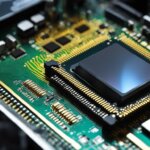Table of Contents
SDRAM, or synchronous dynamic random-access memory, is an essential component in computer systems that plays a crucial role in enhancing overall performance. With a wide variety of RAM types available in the market, it can be challenging to understand the differences and choose the right one.
SDRAM, along with other RAM types like EDO DRAM and Fast Page DRAM, is often misunderstood due to its less glamorous reputation compared to CPUs and video cards. However, comprehending a few basic concepts can make understanding SDRAM and its functionality much easier.
In this guide, we will explore the fundamental concepts and technologies underlying most modern system RAM, starting with SRAM and asynchronous DRAM, before diving into more complex types like Fast Page, EDO, and SDRAM, and exploring more exotic RAM technologies like RAMBUS and SGRAM.
By the end of this guide, you’ll have a solid understanding of SDRAM and its importance in computer systems. So, let’s dive in and demystify the world of RAM!
Storage Theory and RAM Organization
RAM, or random-access memory, is where code and data are stored for the CPU to work with. It is important to understand the basics of storing data in order to grasp the complexities of RAM technology.
RAM storage involves dividing the storage space into small bins and assigning a unique address to each bin. The data bus allows for data transfer into and out of the storage space, while the address bus helps specify the exact location of the data.
To the CPU, RAM appears as a row of addressable storage spaces, with each space holding one byte of data. In reality, RAM is organized in a grid-like structure, with individual bits being stored in a grid of cells.
The address decoder identifies the cell based on the address, activates it, and retrieves the data for the CPU.
“RAM storage involves dividing the storage space into small bins and assigning a unique address to each bin. The data bus allows for data transfer into and out of the storage space, while the address bus helps specify the exact location of the data.”
Synchronous Dynamic Random-Access Memory (SDRAM)
SDRAM, short for dynamic random-access memory, is a crucial component in computer systems that operates in sync with the clock speed of the microprocessor. This synchronization enhances memory performance, making SDRAM a popular choice in modern computing devices.
Organized into multiple arrays of memory banks, SDRAM provides a centralized storage location for temporary data retrieval and writing. These memory banks contribute to the seamless functioning of the CPU and other system components, ensuring efficient data flow.
To maintain data integrity, SDRAM undergoes periodic refresh cycles. These cycles involve restoring the charge in each individual memory cell, preventing any loss of stored data due to charge dissipation over time. Additionally, SDRAM has specific time delays, including the Row-Column Delay (tRCD) and the Column Address Strobe Latency (CAS), which play a crucial role in activation and data retrieval operations.
Understanding the intricate timings and overall organization of SDRAM is vital for optimizing memory performance in computer systems. By taking advantage of the advanced capabilities of SDRAM, system designers and users can ensure smoother operations, faster data access, and enhanced overall computing efficiency.
FAQ
What is SDRAM?
SDRAM stands for synchronous dynamic random-access memory, which is an essential component in computer systems that enhances overall performance.
Why is SDRAM important in computer systems?
SDRAM plays a crucial role in enhancing overall performance by providing centralized storage for temporary data retrieval and writing by the CPU and other system components.
How does SDRAM work?
SDRAM is organized into multiple arrays of single-bit storage sites called memory banks. It is synchronized with the clock speed of the microprocessor, leading to increased performance.
What is the purpose of refresh cycles in SDRAM?
SDRAM undergoes periodic refresh cycles to maintain data integrity, as the stored charge in memory cells can dissipate over time. These refresh cycles restore the charge in each memory cell.
What are the specific time delays required for SDRAM?
SDRAM requires specific time delays, such as Row-Column Delay (tRCD) and Column Address Strobe Latency (CAS), for activation and data retrieval operations.
How does understanding memory performance impact computer systems?
Understanding the organization and timings of SDRAM is crucial for optimizing memory performance in computer systems.







